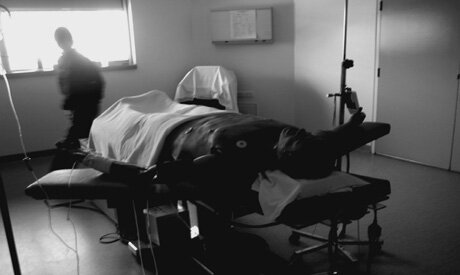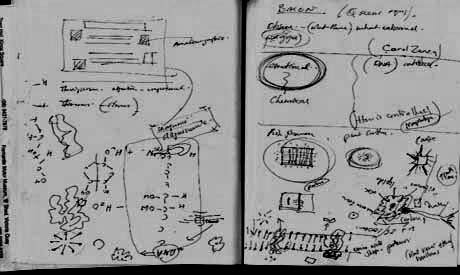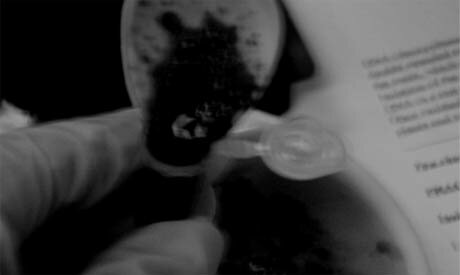Kathleen Rogers: Symbiotica TC&A
In late autumn 2005 I had a semester academic research sabbatical as a visiting artist/researcher at Symbiotica TC&A at the School of Anatomy and Human Biology, University of Western Australia, Perth.


Overview
Symbiotica is an artist run laboratory that can facilitate international artists via proposal and independent or grant funding within a science department and supports artists in learning practical lab work. The Tissue Culture and Art Project was established in 1996 to look into the use of tissue culture as a medium of expression. The TC&A lab was set up by artists Oran Catts and Ionatt Zurr with Stuart Bunt. There are other research groups with different acronyms (MEART, BIOKINO) and their membership evolves in relation to their research themes and objectives. An interdisciplinary culture and intellectual dialogue is developed in and around weekly open house meetings and presentations and a mailing list managed by the anchor woman of the team, Jane Coakley who keeps a growing on-line community informed of events. Symbiotica offer undergraduate and MA studies in art and biology and organise workshops worldwide.

Blood and Bone
I planned to use visit to refine a proposal working with DNA metaphors and the materiality of blood cells. I went to find out more about cell dynamics and tissue culture techniques. I also brought work concerned with bone cell differentiation and the regeneration of deer antlers. This project helped me define specific questions to cell biologists that were useful. I wanted to know the techniques used to grow deer antler using tissue culture and the methods involved in grafting these onto human tissue. I had a meeting with bone expert Miranda Grounds who suggested, with irony, that I try wrestling a deer to the ground to get some velvet antler or review the project. She showed me some work on antler bone grafts on mice that showed tiny lumps like boils on their foreheads. The Neorobiologist, Stuart Bunt talked me through the fundamentals of cell structure and cell membranes and generously described previous examples of TC&A projects. During my stay I had asked to be led on a tour of the basement dissecting rooms, the mortuary, the anatomical collection and teaching rooms. This took in a visit to the plaster casting facility; the refrigeration units for donated corpses and zoological specimens and the networked clinical surgery and virtual operating theatre. The importance of the history of medicine as culture became very clear during my stay and I realised that having a social and historical perspective of the body in medicine is crucial for artists working with human biological subjects as art..


Reflections
Symbiotica is an inspiring place that raises more questions than it can answer. How can one know if artefacts fashioned from biological tissue materials and made by artists are breaching the cultural gap between the arts and sciences? It is difficult to measure and assess. Interestingly, critical art theory is still in its infancy and mostly written by artists themselves and sees them struggling for a coherent context. Can these biological and proposed, semi-living products be part of a counter culture of art activism or are the results another case of deliberately bad art relying on comic phrasing and narrow distribution? Can artists and scientists agree and collaborate to the extent that their efforts and recipes impact on a broader and more inclusive culture without resorting to kitsch or a dumbing down of the art or further obfuscating the science? Then again, is the role of art to make the science more explicit or accessible? Many artists are aware of these contradictions and working with them directly as the major discourse.
Medical scientists, clinicians, bioengineers and biochemists routinely use biopsy and living tissue as part of their work. Skin cells grow are known grow like weeds. Genetically engineered organs developed via stem cells regularly get front-page news. The metaphoric aspects of art are highly persuasive and seductive and this is their unique power. The animistic suggestion that a cluster of cells has a half-life has a poetic resonance that scientists have to chuck out with the bathwater. At Symbiotica artists can pick up the fragments of discarded tissue like scavengers after a blood fest and reversion them as cultural artefacts. Working with cell and lab techniques is close to cookery and many artists take their materials direct from the butchers and sometimes from their own bodies in order to comment on the contradiction and hype and address the minefield of ethical debates and affront the sensibilities of the artworld and popular culture. Some artists get arrested for simply being informed and being artists. The games these artists are playing here carry serious and provocative messages about our biological status as artefactual/toy-like human beings.
Posted by Kathleen on August 30, 2006 7:57 AM to Kathleen Rogers